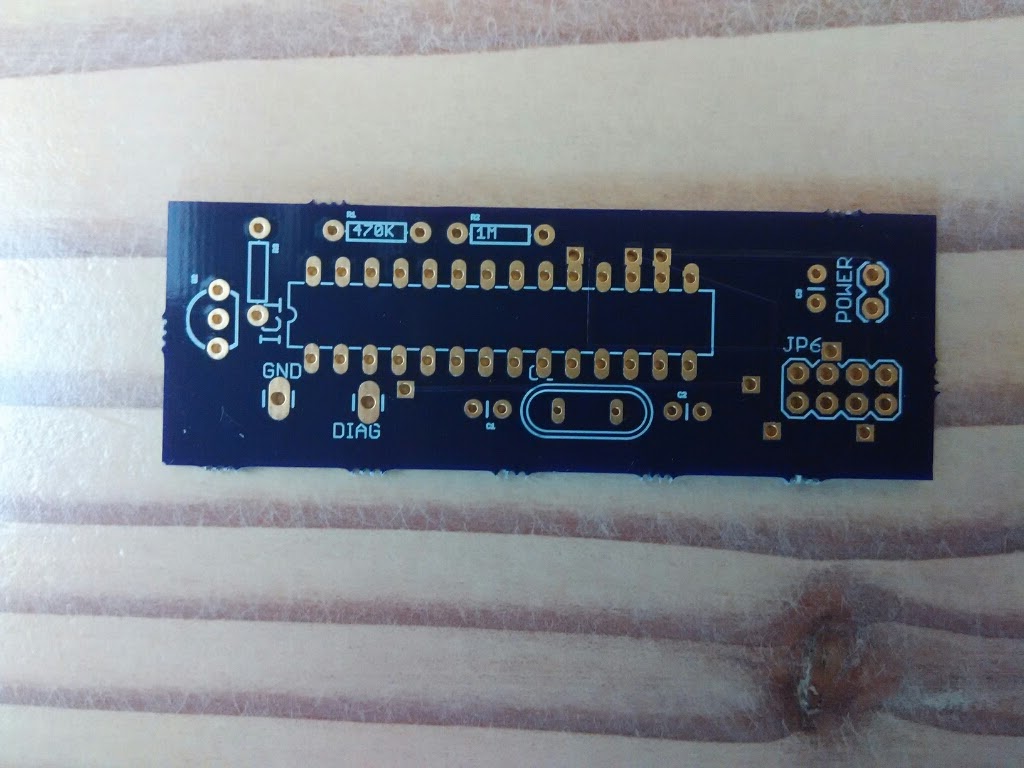sensors in boxes
-
-
@GuyP Thanks!!!!
-
@GuyP Thanks!!!!
@GuyP Ordered 3 from oshpark... 12$. lets see how quickly they get here. so, other than the sensor and the resistors and oscillator (16mhz?) is there anything else there? I am sorry, I am just hopeless at reading sketchs. Is that a diod on the top left?
-
Sorry my fault... I'm not very good at documentation! :(
There are no diodes on the boards... Which board are you referring to.. the TempSensor board just has:
- 1x dallas Tempensor
- 2x capacitors for the crystal
- 1x 16Mhz Crystal
- 1x 4.7uf Capacitor accros the power lines
- 1 resistor for the Dallas sensor to provide power
- 1x 470k resistor and 1x 1m resistor for the battery power level monitoring.
I don't even have the pins for updating the Arduino, I pull it from the socket and write it in a uno board. I do however have a GND, and serial TX pin so I can see the chip working if necessary.
-
Sorry my fault... I'm not very good at documentation! :(
There are no diodes on the boards... Which board are you referring to.. the TempSensor board just has:
- 1x dallas Tempensor
- 2x capacitors for the crystal
- 1x 16Mhz Crystal
- 1x 4.7uf Capacitor accros the power lines
- 1 resistor for the Dallas sensor to provide power
- 1x 470k resistor and 1x 1m resistor for the battery power level monitoring.
I don't even have the pins for updating the Arduino, I pull it from the socket and write it in a uno board. I do however have a GND, and serial TX pin so I can see the chip working if necessary.
@GuyP excellent!! That comes out as a really inexpensive and low power board. What sockets do you use? will these work? http://www.aliexpress.com/item/Free-shipping-17PCS-28pin-DIP-IC-sockets-Adaptor-Solder-Type-28-pin-Narrow-body/32313568228.html?spm=2114.32010308.4.2.lkcXJR
-
Yes it's very cheap and simple to build, When I was etching the boards I was etching 12 at a time and cutting them down.
That 28pin Narrow socket looks to be the right thing (seems to say the right things anyway), the graphic is odd though.
I also bought all the parts in bulk which made for even more savings, specially for resistors and capacitors where I bought maybe 100 and was paying less than 1p a unit.
I was also able to buy the Dallas Temp sensors in bulk and saved quite well on those as well
-
Yes it's very cheap and simple to build, When I was etching the boards I was etching 12 at a time and cutting them down.
That 28pin Narrow socket looks to be the right thing (seems to say the right things anyway), the graphic is odd though.
I also bought all the parts in bulk which made for even more savings, specially for resistors and capacitors where I bought maybe 100 and was paying less than 1p a unit.
I was also able to buy the Dallas Temp sensors in bulk and saved quite well on those as well
@GuyP Yes, i think that they tried to show what chip fits the socket. They move in mysterious ways... I have all the transistors and capacitors i'll ever need (they are really cheap...) but ordered the oscillators so now I have to wait for a week or two. I am not into etching - seems like something I'll manage to mess up. oshpark will print nice pcbs for you for a really reasonable price. I have ordered only 3 so cost is 4$ each but if you order quantity its much much less (and most of the price is the shipping i think :-) ).
I also have some Dallas so I am all set. As I don't have a 3d printer but really good at woodworking I think i'll build some nice oak boxes for these.... -
Oh a few people have suggested these guys for cheap PCB production..
http://dirtypcbs.comI've not tried them myself yet.
-
Oh a few people have suggested these guys for cheap PCB production..
http://dirtypcbs.comI've not tried them myself yet.
@GuyP They are very cheap per board. Might give them a go if the 3 works fine. early days yet!
-
@GuyP PCB arrived from oshpark!

What capacitors did you use for the crystal? and what resistor for the dallas? -
@GuyP It does... Now I realize that if I knew what I was doing (and I don't) it could probably be made smaller and no need for soldering at all.
Thanks! will let you know how it worked out. Might take a bit of time as I am now finishing my AirCon remote sensor.
-
-
@Moshe-Livne Any progress?
can you please explain how this pcb be smaller with no need for soldering
Where are you from? -
@Moshe-Livne Any progress?
can you please explain how this pcb be smaller with no need for soldering
Where are you from?@oded00 Still waiting for the 22pf capacitors...
It was made in resolution for home made PCBs and single layer. oshpark can make the lines much smaller and make more layers so there is no need for soldering the "red" lines. you still need to solder the components (nrf, capacitors etc)
I live in NZ -
@GuyP If I order this brd files online, I assume that I need to remove the red lines from the top layer? Or maybe reroute them if possible? Looks like some short circuit connections.
-
@GuyP If I order this brd files online, I assume that I need to remove the red lines from the top layer? Or maybe reroute them if possible? Looks like some short circuit connections.
@pjeterinfo Oh I didn't notice them. Darn, and I soldered the wires...

